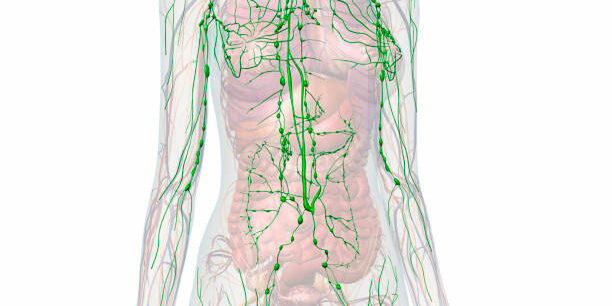You are probably thinking….”what the heck is my lymphatic system” and “how do I know if it’s sluggish”…and “why should I care?” These are great questions. Let’s address them!
The lymphatic system is network of tissues, nodes, vessels and organs that move the lymphatic fluid. The lymphatic system is an important part of both the circulatory system and immune system. Lymphatic fluid is a clear watery fluid made up of toxins, immune cells, and waste products. Lymphatic fluid is moved by the lymphatic system from the tissues back to the bloodstream to be circulated and excreted out of the body. Approximately 20 liters of plasma flows through the arteries to smaller vessels called arterioles and capillaries to nourish our cells with nutrients. Plasma is the fluid that remains after white blood cells, red blood cells and platelets are removed, it contains water, salts, enzymes, antibodies and other proteins. Plasma fluid delivers nutrients to our cells and tissues then collects their waste products. 17 of the 20 liters of plasma is returned to the bloodstream by our veins. The remaining 3 liters of plasma moves through capillaries into the body’s tissues. This excess fluid is collected by the lymphatic system (lymph fluid) which moves it back to the bloodstream where it can be eventually excreted out of the body.
What does the lymphatic system do?
- Collects excess fluid that drains from cells and tissues and returns it to the bloodstream. It is then recirculated around the body
- Absorbs fats and proteins from the intestine and transports it back to the bloodstream
- Supports the immune system by protecting the body against foreign invaders like viruses, bacteria, parasites, fungi that enter the body. The lymphatic system makes up part of the immune system, it produces white blood cells called “lymphocytes” and other immune cells that kill foreign invaders or pathogens
- Transports and removes waste products and abnormal cells from the lymphatic tissue and lymph nodes
If the lymphatic drainage becomes compromised, tissues build up inside the tissues causing lymphedema causing pain, weakness, swelling of the affected tissue (often arms or legs). This is often a complication from surgery or cancer treatment when multiple lymph nodes are removed or damaged. The most common cause of secondary lymphedema is due to mastectomy surgery or radiation treatment.
The more common form of lymphatic dysfunction is a sluggish lymphatic system, which is caused by a sedentary lifestyle, too much processed food, stress or persistent “fight or flight” response that shuts down lymphatic drainage, a high toxic burden in the body that slows down movement of lymph fluid, or liver dysfunction and constipation that cause the lymph system to back up.
Signs and Symptoms of sluggish lymphatic drainage:
- Persistent swollen lymph glands in your neck, armpits or groin area. These are often tender and swollen, usually worse when you are sick and persist for weeks or months.
- lymphangitis (infected lymph nodes)
- Persistent lower extremity swelling (ankles, legs)
- Facial puffiness, puffy eyes
- Skin infections (cellulitis or non-healing wounds)
- Cellulite
- Chronic acne or rashes
- Chronic sinusitis or sinus infections
- Arthritis
- Skin conditions (Itchy skin, acne, rashes)
- Digestive disorders
- Frequent headaches
- Unexplained injuries
- Excess weight
- Chronic fatigue
- Rings get tight on fingers
- Soreness and/or stiffness in the morning
- Bloating / Holding on to water
- Weight gain and extra belly fat
- Low immunity, chronic infections
- Brain fog
- Breast swelling or soreness with each cycle
- Dry skin
- Hypersensitivity reactions or elevated histamine due to common environmental allergens (signs of an overloaded & hyperactive immune system)
- Occasional constipation, diarrhea, and/or mucus in the stool
Easy at-home tools for improving lymphatic drainage:
- Dry brushing skin daily before every shower or bath. Use a skin brush (one of those wooden skin brushes with thick bristles you see at the bath section of the store) start at your feet and brush upwards towards the heart. Brush all sides of body including arms, legs, neck, chest, groin, thighs, back, abdomen. This stimulates the lymphatic system which sits under our skin to drain back into the bloodstream so the lymph fluid can be excreted properly.
- Sweat regularly. Start doing any form of exercise that makes you sweat. Exercise causes muscles to contract and improves circulation and sweating, all of which are needed for the lymphatic system to drain properly.
- Infrared sauna therapy. Must work up slowly to be able to tolerate sweating actively x15-20 min per session. Start low and go slow to tolerate longer amounts over time. It is advised to do sauna therapy under the guidance of a trusted health care provider. An important note with regular sauna use is to make sure to replace minerals or electrolytes that are excreted in sweat and keep well hydrated.
- Use a “Rebounder” or mini trampoline – bouncing stimulates the lymphatic system and opens and closes the lymphatic valves which allows for better flow of lymphatic fluid
- Epsom salt baths. Add 1-2 cups of Epsom salts to a warm bath to stimulate the lymphatic system to drain, this supports sweating. Epsom salts also support lowering stress which also helps the lymphatic system drain better.
- Bentonite clay or other magnetic clays can be added to a bath to further stimulate lymphatic drainage. This can also help stimulate excretion of other toxins through our sweat.
- Lymphatic massage. This is a specialized form of massage therapy that directly stimulates the lymphatic system to drain. It focuses on areas of the body where there are concentrated lymph nodes such as the neck, chest, armpits, stomach, groin, and lower legs/feet. This should be done by a trained lymphatic specialist or by using lymphatic vibration machines which also stimulate lymphatic drainage.
- Drinking fresh organic lemon water daily. use a half to one whole lemon squeezed in water 1-2x day, or add to a smoothie or electrolyte mix. Lemon stimulates movement of the lymphatic system and promotes lymphatic drainage
- Organic freshly squeezed juice from celery, cucumber, parsley , lemon, lime ginger, all help lymphatic drainage and support alkalizing the body. Keeping the body in an alkaline state (rather than acidic state) supports many detoxification pathways.
- Deep breathing. Supports muscle contraction in the chest and abdomen which moves lymphatic fluid in the neck, chest, abdomen. Deep breathing also supports relaxation and relaxes the fascia (network of connective tissue around our muscles and connective tissue) which will allow lymphatic tissue to drain properly. Tense muscles and fascia from excess stress or “fight or flight mode” shut down movement of lymphatic fluid.
- Address chronic constipation. Intestinal muscle contraction is needed to move stool but also to move the lymphatic system in the abdomen and groin areas. Chronic constipation slows down lymphatic drainage in the abdomen/pelvis. Avoiding processed foods, increasing hydration, increasing dietary fiber, and supplementing with magnesium citrate can help resolve chronic constipation. Goal is 2 formed BMs a day to prevent chronic constipation.
Resources:
https://my.clevelandclinic.org/health/articles/21199-lymphatic-system
https://www.healthline.com/health/lymphatic-obstruction



